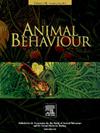The reduction of nuptial gifts in sclerosomatid Opiliones coincides with an increase in sexual conflict-like behaviour
IF 2.3
2区 生物学
Q2 BEHAVIORAL SCIENCES
引用次数: 0
Abstract
Nuptial gifts serve to increase donor fitness through a variety of mechanisms, including securing additional copulations, increasing sperm transfer or storage, or increasing paternity share. Coercive mating behaviour can provide similar male benefits, potentially allowing for evolutionary transitions between solicitous and coercive strategies, wherein male behavioural antagonism could function to secure mates in lieu of nuptial gifts. In temperate leiobunine harvesters (Arachnida: Opiliones), nuptial gifts have been repeatedly lost, resulting in two primary mating syndromes: an ancestral, sacculate state in which males endogenously produce high-investment nuptial gifts and females lack pregenital barriers, and a derived, nonsacculate state in which females have pregenital barriers and males produce significantly reduced, low-investment nuptial gifts. In this study, we investigated whether behavioural sexual conflict is elevated in nonsacculate harvesters by comparing pre-, peri- and postcopulatory mating behaviour between the nonsacculate species Leiobunum vittatum and Leiobunum euserratipalpe and the sacculate species Leiobunum aldrichi and Leiobunum bracchiolum. We additionally sought to establish an automated behavioural analysis pipeline by developing analogues for metrics traditionally scored manually. Our results revealed significantly different, potentially coercive, behaviour in nonsacculate species, indicating that the loss and reduction of pre- and pericopulatory nuptial gifts may contribute to increased behavioural antagonism. Mating behaviour also differed significantly between L. vittatum and L. euserratipalpe, indicating there are multiple suites of potentially antagonistic behaviours. Together, these results suggest that multiple behavioural strategies may be effective substitutes for nuptial gifts in leiobunine Opiliones, although the mechanisms through which male fitness is increased requires further research.
在硬体虫中,结婚礼物的减少与性冲突行为的增加是一致的
结婚礼物通过各种机制来增加供体的适应性,包括确保额外的交配,增加精子的转移或储存,或增加父亲的份额。强制交配行为也可以为雄性提供类似的好处,潜在地允许在关心和强制策略之间的进化过渡,其中雄性行为对抗可以代替结婚礼物来获得配偶。在温带的蜘蛛收获动物(蛛形纲:Opiliones)中,结婚礼物多次丢失,导致两种主要的交配综合征:一种是祖先的囊状状态,在这种状态下,雄性内源地产生高投资的结婚礼物,而雌性缺乏生殖前障碍;另一种是衍生的非囊状状态,在这种状态下,雌性有生殖前障碍,雄性产生显著减少的低投资的结婚礼物。在这项研究中,我们通过比较非荚果种leobunum vittatum和leobunum euserratipalpe以及荚果种leobunum aldrichi和leobunum brachiolum的交配前、交配期和交配后的交配行为,研究了非荚果收集者的性冲突是否会增加。此外,我们还试图通过开发传统手动评分指标的类似物来建立自动行为分析管道。我们的研究结果显示,非囊状物种的行为明显不同,可能是强制性的,这表明在种群前和种群周围结婚礼物的丢失和减少可能会导致行为对抗的增加。交配行为也存在显著差异,表明存在多种潜在的拮抗行为。综上所述,这些结果表明,多种行为策略可能是利奥布尼奥皮龙结婚礼物的有效替代品,尽管雄性适应度增加的机制需要进一步研究。
本文章由计算机程序翻译,如有差异,请以英文原文为准。
求助全文
约1分钟内获得全文
求助全文
来源期刊

Animal Behaviour
生物-动物学
CiteScore
4.60
自引率
8.00%
发文量
236
审稿时长
10.2 weeks
期刊介绍:
Growing interest in behavioural biology and the international reputation of Animal Behaviour prompted an expansion to monthly publication in 1989. Animal Behaviour continues to be the journal of choice for biologists, ethologists, psychologists, physiologists, and veterinarians with an interest in the subject.
 求助内容:
求助内容: 应助结果提醒方式:
应助结果提醒方式:


